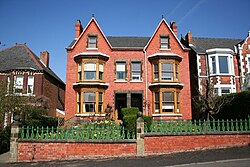Mr Straw's House
| Mr Straw's House | |
|
National Trust | |
|---|---|
 Mr Straw's House | |
| Grid reference: | SK592802 |
| Information | |
| Website: | Mr Straw's House |
Mr Straw's House stands at 5-7 Blyth Grove, Worksop, Nottinghamshire. It is not a grand mansion; it is no more than an Edwardian shopkeeper's semi-detached house, but it and its contents have remained largely unchanged since the 1920s. The house is today owned by the National Trust and opened to the public in 1993.
History
The house was built in 1905 and located on Blyth Grove in Worksop, was the residence of the Straw family. William Straw ran a lucrative grocery and seed company. He had two children, Walter and William Jr., with wife Florence, the daughter of a well-off butcher. They moved from the flat above the shop into the house in 1923, naming it "Endcliffe Villa". Florence quickly got to work on the decoration of her new house. The period features include patterned carpets, thick curtains, and dark, heavy wallpapers that were popular at the time. Oil paintings housed in gilt-frames adorn the walls, though none of the items found in the house are classed as being valuable or particularly rare.
William died suddenly in 1932 while gardening. The family, grieving the loss, decided to preserve the house and avoided all forms of modernisation. William's tobacco pouch and pipe, hanging beside the fireplace, was untouched, and the 1932 calendar was left on the wall. William Jr., who had moved to London to become an English teacher around 1918, returned to the house in 1938, the year before his mother's death. He and his brother Walter continued to run the house without making any changes, resisting modern conveniences. Walter died in 1976, and William Jr. lived in the house until 1985, when he was hospitalised after a fall. Without any heirs to whom he could pass on the property, he decided to bequeath it, and the bulk of his fortune, to the National Trust. He died in 1990.
National Trust ownership
The National Trust took ownership of the property in 1990, their first semi-detached house. Initial assessments of the property quickly revealed the historical preservation that had occurred over the years. Conservators were required to repair sections of wallpaper damaged by damp and touch up sections of the woodwork. The house opened to the public in 1993.
The family threw very little away and lived without many modern conveniences. Brothers William Jr. and Walter were determined to maintain the original feeling of the house. It is believed that a lightbulb once fell from the chandelier into William Jr.'s lunch and he refused to replace it. The empty socket therefore remained.
The house next door is also owned by The National Trust and features a coffee shop and museum room which contains some of the family’s belongings. The display includes William Jr.'s Scout uniform and teacher's gown, as well as early photographs and Victorian furniture and household objects. Many of the items remain exactly where the Straw family left them. Over 12,500 individual items have been catalogued and photographed ranging from tea measures to a two-person Baby Daisy vacuum cleaner from the 1910s.
The property has been described as "the nearest thing to a time capsule that the National Trust has ever received" and "a unique glimpse into family life in suburban Britain between the wars". The house is open to pre-booked tours for small parties of up to four people, with the "cosy" nature of the house limiting the number of people that can comfortably visit at any one time.
Outside links
- Mr Straw's House – National Trust
References
- "Bygones: Mr Straw's House frozen in time in 1932". Nottingham Post. 24 September 2009. http://www.nottinghampost.com/Bygones-Mr-Straw-s-House-frozen-time-1932/story-12225022-detail/story.html. Retrieved 30 September 2013.
- Chewynd, Sam (6 June 2013). "Worksop: Mr Straw’s House celebrates 20th anniversary". Worksop Guardian. http://www.worksopguardian.co.uk/what-s-on/out-about/worksop-mr-straw-s-house-celebrates-20th-anniversary-1-5744638. Retrieved 30 September 2013.
- "National Trust, Mr Straw's House". BBC. http://www.bbc.co.uk/arts/yourpaintings/galleries/locations/national-trust-mr-straws-house-6700. Retrieved 30 September 2013.
- Arkell, Harriet (12 July 2013). "The house that time forgot: Mother and sons keep family home frozen in the 1920s for 70 YEARS with original decoration, food and furniture". Daily Mail. http://www.dailymail.co.uk/news/article-2361731/The-house-time-forgot-Red-brick-semi-frozen-1920s-original-decoration-food-furniture-untouched-90-YEARS.html. Retrieved 30 September 2013.